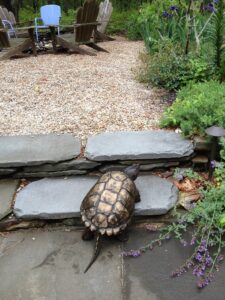When people design a back yard suitable for wildlife, they tend to create places that are appealing to birds and butterflies. That makes sense, because these animals are appealing visitors when they’re in our gardens. But gardening with sensitivity to wildlife can encompass more than just planting beds that attract these charismatic species. What about a habitat to please a nesting turtle?
The idea of creating gardens for turtles isn’t particularly common, according to Bob Prescott, director emeritus of Mass Audubon’s Wellfleet Bay Wildlife Sanctuary. Both Prescott and the sanctuary’s turtle research coordinator, Jessica Ciarcia, know plenty of homeowners who have hosted nesting turtles without even trying, though. With the right techniques, they say, nearly any yard on Cape Cod can become a suitable habitat for turtles.

Turtles nest in the late spring. Snapping turtles are the first, Prescott says, laying eggs around the end of May. The other species follow in June, with terrapins and painted turtles sometimes nesting a second time in July.
Which turtles you might attract depends on the location of your property. There are six species of turtles that nest on the Outer Cape. Three of them — the enormous snapping turtles, diminutive painted turtles, and dark-colored musk turtles — breed mostly around ponds and streams. If you live in the vicinity of a freshwater wetland, even if you’re a mile or two away, your yard may be right for these turtles to nest in.
Then there are two turtles with more specific habitat requirements. If you live in the vicinity of a cranberry bog, there’s a chance the rarer spotted turtle might be attracted to your yard, Prescott says. The salt-water-loving diamondback terrapin is common in the right habitat on the bay side of Wellfleet and Eastham; if you live within a few hundred feet of a salt marsh, they’re the ones you could attract.
That leaves the box turtle. Though these are the most widespread turtle, they are also listed as a species of special concern in Massachusetts. These yellow-and-black turtles with high domed shells spend nearly their entire lives in and around forests and forest edges, a habitat preference so common that most yards on the Outer Cape could potentially host a box turtle nest — “No pond necessary,” Prescott says.
If you want to attract a turtle of any kind, you’re going to have to mess your yard up a little bit. Turtles prefer to nest in disturbed habitat — that is, land that has been opened up by storms, fire, or other destructive forces. Prescott recalled a time when a microburst destroyed a patch of forest at the Audubon sanctuary in South Wellfleet. Within two years, he says, box turtles were coming out of the woods and nesting there.

Prescott recommends creating what he calls a “Cape Cod lawn.” It’s sandy, with patches of grass and small plants. A yard with a sought-after-in-suburbia green lawn will dissuade turtles from nesting. You want to see the sand, Prescott says, though different turtles have different preferences. Painted and snapping turtles don’t mind some grass, while terrapins and box turtles require as little lawn as possible where they nest.
The plants to go for include bearberry, little bluestem, poverty grass, beach heather, and even prickly pear — plants that thrive in patches of sandy soil. Turtles will tend to nest at the edges where patches of plants meet the open ground.
A low-budget approach would ignore special plantings and instead focus on creating bare spots by ripping out patches of grass about four inches across. It’s an approach, Prescott concedes, that is not going to win you any landscaping awards. Taking out a dozen or so patches is important so as not to allow both turtles and their predators to zero in on just one spot.

Other human-made landscapes that are incidentally attractive to turtles include sandy driveways or roads. Turtles will readily nest on the edges of well-trodden paths. With their sharp claws, they can easily dig through compacted soil to lay their eggs, says Ciarcia, so long as there is no layer of rock underneath it.
If you spot a turtle nesting in your yard, Prescott and Ciarcia recommend covering the nest with a large bucket or trash barrel to protect it — but only temporarily. Turtle nests are most vulnerable to predators in the first few days after the eggs are laid, because that’s when their smell is the strongest.
After one or two days, though, it is vital to remove any protection. Turtle nests need sunlight, since their sex is determined by their eggs’ temperature during development. If a nest is too cold, all the turtles will be males. Removing the protection allows the nest to heat to its ideal temperature.
For the same reason, it is important to avoid overwatering the area of your yard where turtles might be nesting. Moisture cools the soil, Prescott says, and could throw off the sex ratio.
Then it’s just a matter of waiting for a little over two months. Some nests will inevitably fail, but if you’re lucky, you may wake up one day and find that your yard is suddenly full of a new generation of turtles.



